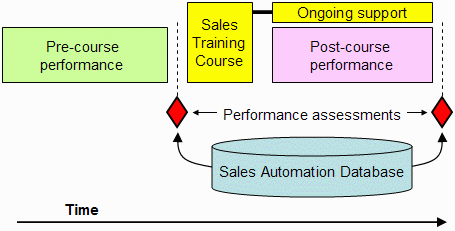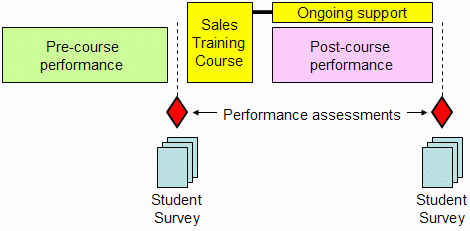Put “Earn” in Your Learning
by
D. Verne Morland
Managing Partner
ROI Learning Services
| Abstract: |
Many companies view training as a component of their employee benefits package - an expense to
be controlled, not an investment to be maximized. This attitude is dangerously outdated. Survival
in today's global economy requires continuous, cost-effective, world-class training. With the
right approach it is possible to identify the “earn” in learning and measure the results as you
would with any other business investment. |
New York retail legend John Wanamaker once said, "Half of my advertising is wasted ...the trouble is, I don't
know which half." Many businesspeople feel the same way about training and the root cause of their distress
is similar to their concern about advertising: the relationship between cause and effect is unclear.
Start with the Business Objectives
It doesn’t have to be this way. Most good training programs begin with an analysis of job activities and
identify the knowledge, skills, and attitudes that are required to perform those activities successfully.
This is certainly not a bad place to start, but a critical first step is often overlooked – what business
problem is the training intended to solve? Or to put it more positively, what new business opportunities
is the training designed to create? To many of us the answers may seem so obvious that we do not give the
questions much thought, but by examining them in detail we can often identify specific points of impact
that we can later measure.
A Sales Training Example
For example, my company - ROI Learning Services - is working with a company that specializes in sales training.
Two of their courses are designed to help salespeople overcome their reluctance to contact new prospects and
to help them contact higher level people in their prospects’ organizations. With this kind of focus, the task
of measuring business impact becomes easier. The key is to create a hypothesis that links the training with
a business metric and then to establish a performance baseline against which improvement can be measured.
In this case of there are two scenarios.
Scenario 1: Mining Data from a Sales Automation System
Client companies that have a high degree of sales force automation may already be capturing
the data needed to assess the training’s impact. For the courses described above, this would be the number of
new prospects each salesperson contacts per week and the titles of the people with whom they are talking.
Using a database it is reasonably straightforward to produce reports on the salespeople before they take the
class and again three to six months after they finish the class. Performance improvement goals can be set,
say a 15 percent increase in the number of new prospects contacted per week and a one level increase in the
organizational position of the people they contact. This scenario is illustrated in Figure 1.

Figure 1: Comparing Sales Performance Using a Sales Automation Database
Ongoing Performance Support is the Key to Success
Notice that one of the keys to improving post-course performance is the provision of ongoing support. Too
often training interventions are one shot events: the students come to the course, receive new information,
practice new skills, and are motivated by the instructor and their fellow students to apply what they have
learned when they get back to the field. Of course, we all know what usually happens: when they return to
their offices the rest of the company is practicing business as usual, no one else attended the course, and
most students revert to their pre-course behavior almost immediately.
Practical, Low-Cost Technologies Can Help
With effective post-course follow-up the real world impact of training can be dramatically improved. Using new
technologies, like email and the web, and more traditional, personal follow-up, students can be periodically
re-motivated and their skills refreshed, overcoming the deadening effects of the status quo and the loss of
knowledge and skill that can occur as time passes after a class.
Scenario 2: Gleaning Data from Surveys
The second scenario for our sales training example applies to companies that do not have
sales automation systems or when their systems do not capture the relevant information. In such cases student
surveys can be used as illustrated in Figure 2.

Figure 2: Comparing Sales Performance Using Student Surveys
Good Data Requires Good Surveys
This approach requires that careful attention be paid to survey design and methodology. Whenever you ask
people to report on their behavior there are many factors, both conscious and unconscious, that can bias
their responses. When salespeople are asked how many new prospects they approach each week, they may be
inclined to pad their numbers unless they are confident that their data will never be directly associated
with them as individuals. Even if they have this confidence, they may unconsciously over- or under-estimate
their performance due to the well documented gap between behavioral reality and subjective perception.
By providing assurances of anonymity, by correctly wording the questions, and by comparing input from the
salespeople, their supervisors, and peers, reasonably accurate baseline and post-course data can be obtained.
Other Ways Training Can Improve Business
What are some other ways that training can improve a business? There are four major areas of impact:
1) effectiveness (usually tied to increased revenues), 2) efficiency (usually tied to reduced costs and
improved profitability), 3) employee satisfaction and retention, and 4) customer satisfaction. In many
cases the impact of training will be less directly measurable than in the example provided above, but it is
still important to develop a hypothesis that specifies where training will make a measurable improvement in
the business and then to test that hypothesis.
The Training Manager Should Be a Strategic Business Partner
Business leaders too often bring trainers into low performing business environments and ask them to make
only tactical improvements to employee performance. We can make a much more important contribution by taking
the initiative to become partners with business leaders. A good first step in this direction is to initiate
a discussion about training’s return on investment or ROI.
ROI Starts the Right Discussion and Leads to the Right Answers
ROI always gets a business person’s attention and the discussion can lead to the identification of specific
opportunities for training to contribute to key components of the company’s business strategy. By
understanding the expected impact of training on the business in greater detail, we can measure that impact
and demonstrate the business value of training.
About the Author:
 |
D. Verne Morland is a leader in the application of internet technologies to facilitate learning
and improve organizational effectiveness. He defined and directed the implementation of a global
online university serving over 30,000 corporate users. Verne was a member of the core management
team that consistently reduced NCR Corporation’s cost of learning while increasing course completions.
Verne is the managing partner at ROI Learning Services and can be reached via email at
verne@roi-learning.com. |
To download a PDF version of this paper, click here.
###
©D. Verne Morland, 2003.
|